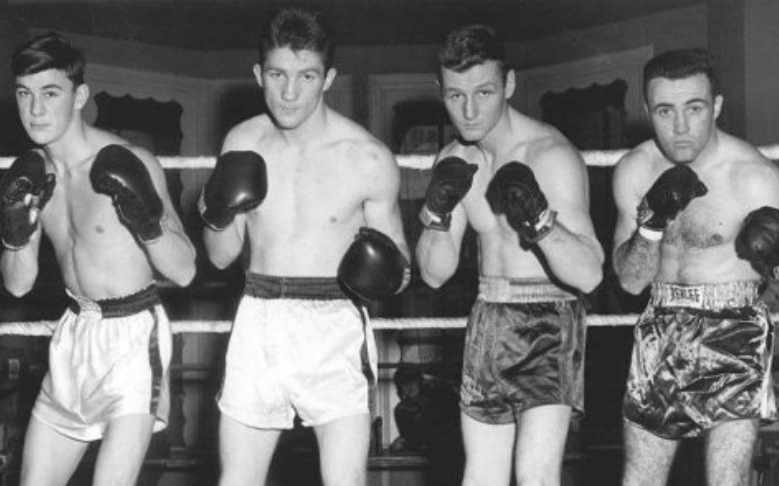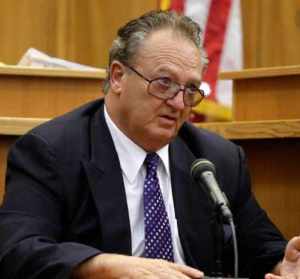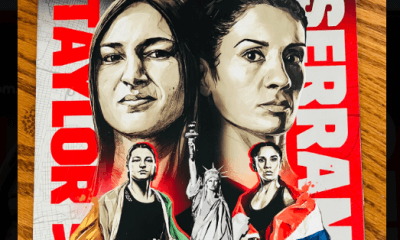Featured Articles
The Friends of Tony Veranis, Part Two

The Friends of Tony Veranis, Part Two
During the period between 1966 and 1976, New England’s criminal underworld included many ex-boxers from the Boston area, many of whom were destined to die a violent death. Their intertwined histories would match those of George Higgins’s “The Friends of Eddie Coyle” except that here the common denominator is boxing.
Part One introduced many of the main characters including the notorious Joe “The Animal” Barboza. Next up is journeyman heavyweight George Holden who would meet his end along the banks of the Mystic River.
George Holden (1948-1973)
George, known as the “Medford Irisher,” fought mostly out of Portland, Maine as a heavyweight and chalked up a less-than-glorious record of 15-26-3. He went 9-3-3 in his first 15, but then the losses came in bunches and he would lose nine of his last 10. In his last bout against Jimmy McDermott (52-16-3), Holden disgraced himself by showing up drunk for which he was indefinitely suspended. He never fought again.
Like Rocco DiSiglio (introduced in Part One), little is known about Holden’s personal life except that he was a low-level operative in organized crime. Holden trained with the usual suspects and met a similar fate. On August 23, 1973, his body was found washed up along the mucky shoreline of the Mystic River in Charlestown, Mass. He had been executed gangland style with a gunshot to the head. George was 25 years old. His killers were never found. Holden’s murder was the 82nd homicide in the city of Boston in 1973.
Eddie Connors (1933-1975)
As a youth, Connors was a regular at the L Street Curley Gym and Bathhouse located in South Boston (i.e. Southie) where future gang leaders Stephen “The Rifleman” Flemmi, James “Whitey” Bulger, and Frank “Cadillac Frank” Salemme hung out.
Eddie, nicknamed “Bulldog,” was a respected heavy-handed middleweight who fought like a bulldog during the ’50s and ran up a slate of 22-7-1 with 18 KOs against tough opposition. His last three fights — all losses by decision — were against Willie Green (27-4), Joe DeNucci (20-2 coming in), and former world champion Tony DeMarco (55-11-1). He also held the very capable George Monroe (37-13-3) to a draw. His brother James Connors (not to be confused with Jimmy Connors who fought out of New Bedford from 1957 to 1963 and who was trained by Clem Crowley) fought between 1959 and 1961 and retired with a 13-0-1 record.
Eddie would later use his boxing experience to handle drunk and disorderly customers in his notorious Bulldog Tavern in the edgy Savin Hill area of Dorchester –sometimes referred to as “Stab and Kill”— where he acted as both bartender and bouncer, and which he also used as his criminal headquarters for illegal gambling, drug dealing, loan sharking, and for planning armed robberies with his associates.
Later, because Connors was bragging too much about a murder he had helped orchestrate (of one James “Spike” O’Toole), the Bulldog had become a dangerous loose end. As such, he was set up for an ambush in The Dot. When Eddie arrived at a service station on Morrissey Blvd. on June 12, 1975, to make a pre-arranged phone call, a young Whitey Bulger, John “The Basin Street Butcher” Martorano, and Stephen Flemmi were waiting armed to the teeth. Connors was nearly cut in half in the phone booth by the hail of heavy artillery and the loose end was tied. Curiously, the deadly Martorano was the one who had machine gunned O’Toole in 1973.
Americo Sacramone (1937-1976)
When he finished his brief boxing career with a 5-1 record, Rico, from Everett, entered the rackets as member of Boston’s Winter Hill Gang. After being wounded in the hit on Buddy McLean in 1965, Rico went back to prison on a parole violation. In 1976, he was gunned down — this time for good — by parties unknown.
During his boxing days, Sacramone would often spar with the great Joe DeNucci (54-15-4), who later became the longstanding State Auditor of the Commonwealth of Massachusetts.
Tommy Tibbs (1934-1975)
While probably not a friend of Tony Veranis, Tommy (60-77-4) did fight George Monroe three times in 1953 — and just about everyone else including Willie Pep whom he beat in 1958 — and since Monroe fought to a draw against Eddie Connors in 1955, at least the possibility of a dotted line connection exists. Monroe was from Worcester and Tibbs made his residence in Boston. However, where Tommy warrants an honorable mention is the fact that he was shot and killed in a dispute in a Roxbury bar in 1975, one of the bloodiest years of living dangerously in Boston.
Back to Tony (1938-1966)
Meanwhile, after beating Al Pepin in his pro debut, Veranis continued his attention-grabbing run as a professional. He was described as “one tough SOB; a Wildman who was courageous in the ring.” Others said he was well-trained and “a great prospect and that his boxing style was that of a slugger.”
In 1957, Tony fought an astonishing 26 times (the majority at the Rollway Arena in Revere). Tony’s best win may have been on December 3, 1957, when he stopped — and retired — the talented Bobby Murphy (19-3-1). Bobby, a former USA New England welterweight titleholder, had impressive wins over Vic Cardell (65-25-7), Fitzie Pruden (50-21), Rocky Sullivan (66-43-12) and Jackie O’Brien (65-17-8), as well as a draw with top contender Chico Vejar (63-5-1). A win over Murphy meant something.
Tony’s last fight in 1957 was against rugged Barry Allison on December 17 against whom he fought to an admirable draw. Allison (40-19-2) was at the center of New England boxing during the 1950s but was never able to reach world championship level though many think he should have gotten the nod against Johnny Saxton in 1958. As for Tony, he slaughtered Silby Ford in a bloody encounter in February 1958, one that had blood-splattered ringsiders aghast as Silby’s teeth and mouthpiece were knocked out. This moved Tony’s record to 25-0-2 before dropping back-to-back fights to Allison in a rematch for Allison’s USA New England middleweight title and to undefeated Joe Devlin at the Boston Garden.
Tony’s loss to Allison was one in which he took a terrible beating and one that undoubtedly rendered him damaged goods going into the Devlin bout — not taking anything away from the crafty Joe who would retire undefeated. These two fights occurred within a 16-day span in March 1958. After his brutal knockout defeat to Devlin in which he was decked in every round, he was taken to Boston City Hospital in bad shape and remained in a coma before recovering some three month later. But his boxing days were over.
After boxing, Tony reportedly suffered from severe migraine headaches, nausea, temporary mood swings, and blackouts — maladies that apparently were not treated and pointed to brain damage. When combined with heavy drinking and depression, this lethal mix could only spell major trouble for an ex-boxer. Tony was arrested for an unidentified crime on December 23, 1963, and sent to prison in Norfolk, Massachusetts.
While incarcerated he supposedly became an altar boy to serve at prison mass, prompting the prison chaplain Father John Fitzgerald to say, “He wanted to get straightened out, and I think he did. He was a wonderful boy who’d run with a bad crowd. He frequently stopped in to see me… after he got out, and everything seemed to be all right. He took me to the fights, and he was with respectable fellows.” Some portrayed him as a friendly and quiet guy who was the victim of circumstances beyond his control, but other saw him as a small-time hoodlum and mean drinker with a bad personality change who was more brawn than brain. Street lore and my own in-depth research clearly support the latter depiction.
Tony soon found himself in debt to South Boston loan sharks and being overdue to such types was hardly conducive to one’s well-being. Tommy DePrisco, a Barboza associate, attempted to collect from Tony in a South Boston bar but was embarrassed, maybe even punched, and forced to leave as this was Tony’s hangout. The following night, hitman John Martorano was at Billy O’s tavern in Dorchester when Veranis braced him and reportedly slurred, “I’m Tony Veranis, you know who I am. I just had a beef with your friend [DePrisco]. I kicked him outta Southie with his tail between his legs, f*** him and f*** you, too.”
As Tony allegedly reached for his gun, the taller “Butcher” beat him to the punch and fired down into Tony’s skull twice, blowing what was left of his already damaged brains all over the place. His body was dumped in the Blue Hills wooded area off Route 28 near where Milton and Dedham meet. He had $2.83 in his pocket. This was the end result when two former altar boys met up at the wrong time in the wrong place. One was 27, the other 26. Tony may have been tougher with his fists, but the Basin Street Butcher was faster with his gun.
John Martorano: Last Man Standing
“You Just Kill Them Before They Kill You” John Martorano
Many claimed credit for the hit on Tony Veranis and a few even suggested that Barboza was involved, but the most reliable accounting is that Martorano (known as “The Executioner,” among other aliases) was responsible. Early on, Martorano, who also was an altar boy, a good athlete, and well-educated in private schools, showed a marked proclivity for conflict resolution. He eventually became the chief enforcer for the Whitey Bulger gang, running up an astounding tally of 20 confirmed hits (all carried out in a cold, detached, so-called “professional” manner).
One of John’s familial Old World core values was that of loyalty, and when he later learned that Bulger and Flemmi were FBI informants who leaked useful information, some of it even accusatory against John, he became enraged. The fact is, he flipped out and then proceeded to flip on the flippers, becoming a key government witness and in the process exposing the links between the Bulger gang and the FBI’s Boston office. In return for his “cooperation” and confession to 20 murders, he served only 12 years and received $20,000 gate money upon his release. Said U.S. Attorney Donald Stern, “The only thing worse than this deal was not doing this deal.”

martorano
Regarding his hits, Martorano incredibly and calmly said, “I always felt like I was doing the right thing. Even if it was wrong, I always tried to do the right thing.”
Strictly business? Hardly. These sociopaths were close to being serial killers and they loved it.
Today, while the mother of all rats, Whitey Bulger, was recently beaten to death in prison, John Martorano and Kevin Weeks (another deadly Bulger enforcer and righteous snitch who wrote the compelling “Brutal: The Untold Story of My Life Inside Whitey Bulger’s Irish Mob,” are free to walk the streets of Quincy, Dorchester, and South Boston having done their time and having made their deals. Maybe they take strolls on Carson Beach.
Unlike Barboza, they don’t need any witness protection because there is no one left from whom to be protected. Moreover, there IS something to be said for ratting out a rat.
John “Red” Shea (standup guy)
You don’t tell on anybody, you accept your responsibility, even if the other person can’t. You’re to be a man and keep your mouth shut. Period. There’s no gray area.” –Red Shea
There was another ex-boxer, but he chose another, more difficult path. His name was John “Red” Shea and he traded an exceptionally promising boxing career for a more lucrative life as an important operative and enforcer for the Bulger gang. But the thing about Red was that when he was finally caught, he didn’t flip, but held fast to the Irish code of silence. The 47-year-old Red served out his 12 years in prison without ratting out and is now considered a rare man of honor in the Boston area. He went on to write the hot selling “Rat Bastards: The Life and Times of South Boston’s Most Honorable Irish Mobster.” Red is now enjoying his freedom and the secrets of his life of crime most likely will be taken to the grave with him. His second book, “A Kid from Southie” was published to solid reviews.
Famous defense attorney Anthony Cardinale, a close friend of Red, once said, “He’s not big, but was very violent and very tough, and people are, to this day, scared to death of him…If, God forbid, I ever needed somebody next to me and I needed backup he’d be one of the first guys that I would ever go to.”
Joe DeNucci and Clem Crowley went on to live honorable and even celebrated lives before they passed, as did Joe Devlin, New Bedford’s Jimmy Connors, and Barry Allison. However, Eddie Connors, Rocky DiSiglio, Rico Sacramone, Joe Barboza, George Holden, and Tommy Sullivan — all fighters in the Boston area who were connected to one another in one way or another — were each murdered at a young age. I still meet with Jimmy Connors on a monthly basis in Dorchester and never tire of his stories from the past.
As an aside, I interviewed Joe Devlin about his fight with Tony at a lunch meeting at the Florian Hall in Dorchester. Among other things, Joe said that Tony’s brains were like “scrambled eggs.” Sadly, the affable Joe died of a heart attack on the very next day.
“Boxing got me out of a lot of trouble. It does that for a lot of kids.” – Tony Veranis
Pictured: Tony Veranis and Bob Murphy. The full photo has Pat MCarthy on the far left and Jimmy Connors on the far right.
Ted Sares can be reached at tedsares@roadrunner.com
Check out more boxing news on video at The Boxing Channel
To comment on this story in The Sweet Science CLICK HERE
-

 Featured Articles4 weeks ago
Featured Articles4 weeks agoAvila Perspective, Chap. 330: Matchroom in New York plus the Latest on Canelo-Crawford
-

 Featured Articles3 weeks ago
Featured Articles3 weeks agoVito Mielnicki Jr Whitewashes Kamil Gardzielik Before the Home Folks in Newark
-

 Featured Articles1 day ago
Featured Articles1 day agoResults and Recaps from New York Where Taylor Edged Serrano Once Again
-

 Featured Articles6 days ago
Featured Articles6 days agoFrom a Sympathetic Figure to a Pariah: The Travails of Julio Cesar Chavez Jr
-

 Featured Articles4 weeks ago
Featured Articles4 weeks agoCatching Up with Clay Moyle Who Talks About His Massive Collection of Boxing Books
-

 Featured Articles1 week ago
Featured Articles1 week agoCatterall vs Eubank Ends Prematurely; Catterall Wins a Technical Decision
-

 Featured Articles3 weeks ago
Featured Articles3 weeks agoMore Medals for Hawaii’s Patricio Family at the USA Boxing Summer Festival
-

 Featured Articles4 weeks ago
Featured Articles4 weeks agoRichardson Hitchins Batters and Stops George Kambosos at Madison Square Garden





















